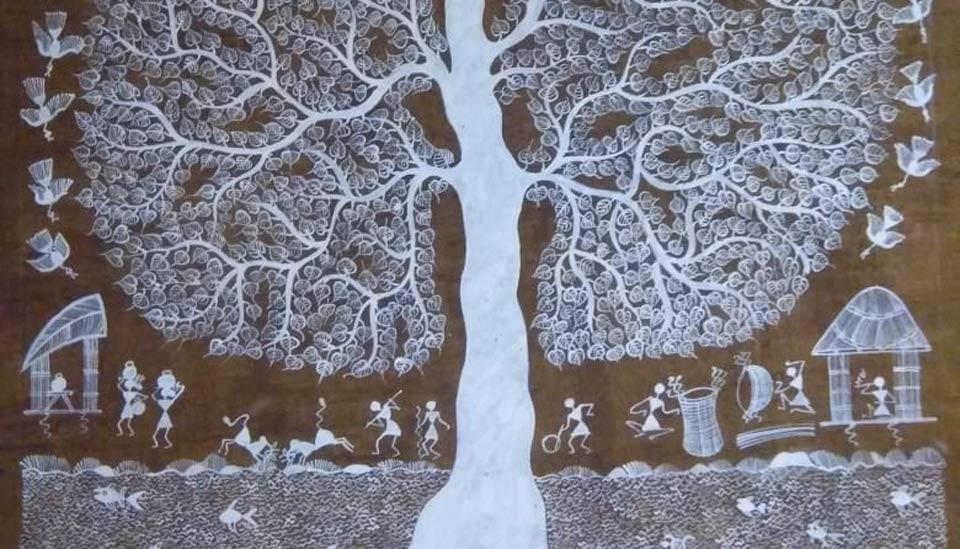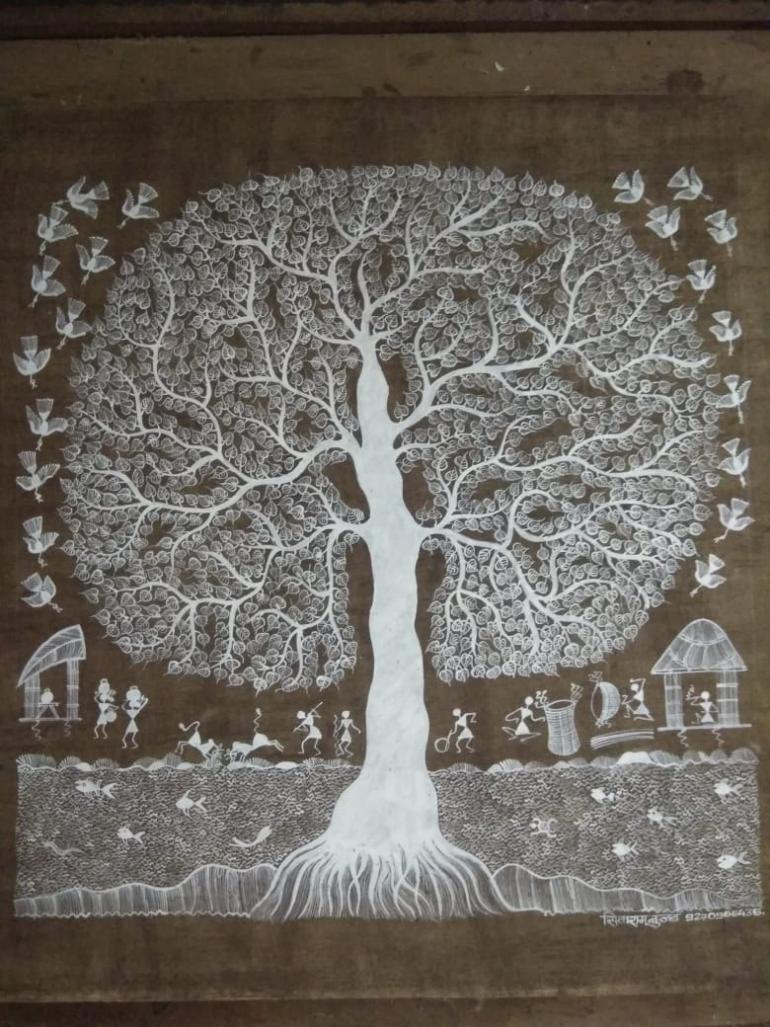
Image description: Warli art depicting tree foliage and people doing different things below the shade. Photograph source: Authors
In a fast-changing world that we live in today, our lives are dominated by the internet and connected devices. Technology has revolutionized our lives bringing about far-reaching changes, impacting society and enabling bringing about economic growth. A large part of the global economy is majorly benefitted through contributions from the digital economy. However, in the midst of this, women still face challenges and constraints in accessing, using and utilising technologies to enhance their quality of life. Economic, cultural and social factors play an important role in determining how effectively women can benefit and contribute from/to this technological advancement. As women comprise half of the world’s population, the UN’s Sustainable Development Goals (SDGs) need to address each of the SDG goals through a gendered lens. This will enable us to achieve the 2030 agenda ‘a better world for all’. One of the important ways by which this goal will be addressed is through improving access to innovative technology universally. Hence, we focus on better understanding this through women and new technologies alongside the role of gender in technology and innovation. The new technologies are an interesting paradigm that has not only broken various barriers and divides in society but has also created new barriers and divides as well. This is because there are obstacles and challenges in the acceptance of new technologies that hinders enablement and women's empowerment.
In this study, we define ‘new technologies’ as technologies that are a result of the innovation of older technologies and aim at transforming lives. These technologies are often considered as threatening and unfamiliar and are often viewed as ‘unacceptable’. However, with new sustainable innovation, technology has become an empowering agent in the lives of people, especially the rural population. This article concentrates on women and their interaction with internet connectivity which is largely accessed through mobile phones. The work bases itself on case studies of our interactions with women in community networks i.e. Janastu[1] and Gram Marg[2] and BAIF[3] and Digital Empowerment Foundation (DEF)[4] in India. We focus on how these women use and utilise the online and offline connectivity provided by these community networks on their smartphone and contribute to the digital economy. The reasons are predominantly i) unequal access ii) differentiation in the capacity to meaningfully use and utilise connectivity and iii) insufficient digital skills. The second section of the article highlights how rural woman have used the connectivity and internet as part of their daily income source and making them independent. The last section sets out recommendations to complete the cycle of connectivity and women entrepreneurship.
Connectivity & Women: A road towards entrepreneurship
Gender plays a significant role in determining the acceptance of new technology. Two critical factors influence whether women can access the internet or not - availability and affordability (Weingarten, E. 2013). Various research studies show that adoption of new technologies is higher with men, as they generally are more technologically adept than women (Westland and Clark 2000, Goswami and Dutta 2015). A study by Kelkar and Nathan (2002) argues that IT enabled services are beneficial both to men and women with limited skill set and educational background. However (education and skill) these are not the only qualities that can assure good usage of the technology, as there are other determining factors like learning capacity, usefulness, ease of operating the technology, local language content which also plays an important role.
Gender gaps are more pronounced in developing countries than developed countries. Women in low-and middle-income countries are on average, 10% less likely to own a mobile phone than men. This means that 184 million fewer women own mobile phones, according to the Mobile Gender Gap Report 2018. An equal share of men and women in India use phones to make and receive calls, however, the gender divide is heavily noticeable for more sophisticated services such as surfing the internet or downloading the apps. Nevertheless, women in rural parts of India are defining and understanding the use of the internet in their own way. Starting with WhatsApp and Facebook, women in rural areas are searching for recipes or artwork, etc on YouTube and upgrading their skills. The usage of the internet can lead to an increase in economic capital due to enhanced opportunities for businesses or their profession. Social capital can also lead to an increase in knowledge that could further enhance economic or social status.
An equal share of men and women in India use phones to make and receive calls, however, the gender divide is heavily noticeable for more sophisticated services such as surfing the internet or downloading the apps.
Putnam (2000) defines “Social Capital” as a set of horizontal associations among community members for leveraging their existing resources embedded in the network. Yang (2007)[5] defines Social Capital as a collective property, where individuals can draw personal benefits at different levels through the social groups or networks that each individual member can access and hence Social Capital can be measured at the individual level too. Nahapiet& Ghoshal (1997)[6] considered Social Capital as i) structural that consist of the ties and relationships embedded in the network; ii) relational consisting of factors such as trust and motivation; iii) cognitive consist of shared vision, motivation. According to (Beugelsdijk and Smulders, 2003[7]; Lancee, 2010[8]; Leonard, 2004[9]; Ryan, 2011[10]) “structural capital” usefully bridges networks, creating economic capital by supporting employment and enhancing income. The community networks in India have proven that engaging women in community networks not only helped them to be economically viable but also make the women socially acceptable.
Community networks such as GramMarg& BAIF’s project and Janastu are using connectivity to not only connect these rural women but also enabling them to integrate the connectivity in their day to day lives. Such as means of accessing information, attaining health services, cashless transaction, preserving their local knowledge and culture and many other things as per their choice to meaningfully use the connectivity after being connected.
Case study 1: Location: Gram Marg and BAIF Community Network at Pathardi
Respondent: Anjali, Banking Correspondent at Pathardi village, Aged 26 years.
Anjali truly reflects how connectivity can be used for the purpose of improving livelihoods alongside an enterprising solution to be economically empowered. She lives in Solepada (a hamlet of Pathardi village) with her 4-year-old son. She is a single mother and financially needs to support her family. Under BAIF’s eDost programme (youth in the village who help the community to make use of the digital services), she has been trained to use digital skills and digital tools like smartphones. She studied till 10th standard and has been actively engaged as an eDost for over one year. In Pathardi, the nearest bank is 14 kms away, so if any community member wants to pay about Rs. 50 - Rs.100 (USD 70 cent to USD 1), which itself is a huge amount for local people, they have to travel that far.
As part of APC's Community Network Learning grant (Pathfinder grant), Anjali is now acting like mobile bank/ATM, also known as ‘banking correspondent’ for local members using the connectivity and her smartphone. Through the AEPS enabled biometric device, she can help the villagers withdraw money from their bank account, inform them about their bank balance and also help the villagers to fill forms related to e-Governance services, including birth certificate, death certificate, marriage certificate etc. Anjali cycles down the village going from door-to-door asking people if they would require any banking facility or e-Governance services. Being a banking correspondent, she earns Rs.2500 to Rs 3500 (USD 34 to USD 50). Anjali is the first woman entrepreneur and her work establishes that connectivity can be used in multiple ways beyond accessing entertainment.
Anjali cycles down the village going from door-to-door asking people if they would require any banking facility or e-Governance services.
Case study 2: Location Janastu Community network at Halekote village in Tumkur, Karnataka.
Respondent: Siddhavva, Master Trainer at Janastu Crafter Space in Halekote village
Siddhavva, trains other women to make baskets and other utility items with 'Rush Grass' (a variety of grass that grows on still water) – a local resource from the village. The grass is used to make beautiful bags, folders, lampshades, baskets and mats. Being a Master trainer, Siddhava innovates new designs and guides the other women who come to the Crafter Space to make products out of 'rush grass'. The crafter space provides Siddhava and the other women a safe space where they spend most of their day weaving baskets. This space is also a location where women exchange information amongst themselves, discuss, share skills and knowledge, and work together. Siddhavva's monthly income is INR 10,000 (USD 140) on an average. She uses the connectivity provided by Janastu community network to operate the smart phone received under APC's Pathfinder grant project. She uses the smartphone to see new designs for baskets and bags and to be connected with the market, to access different types of information like health- and hygiene-related information to watching songs. She also uses it to train artisans and craftsmen in other remote locations, upload and search newly made hand-woven baskets on the website. Siddhavva is illiterate, yet she uses the Internet with ease through voice search and also some help from her daughter Bhoomi and other women in the craft center. Being illiterate has not held her back in becoming an entrepreneur. She mentions that her skills in basket weaving have empowered her while the internet has helped her to innovate.
She uses the smartphone to see new designs for baskets and bags and to be connected with the market, to access different types of information like health- and hygiene-related information to watching songs.

Image description: Warli art on a wall depicting tree and people doing different things under its shade. Photograph source: Authors.

Image description: Warli art on a wall depicting tree and people doing different things under its shade. Photograph source: Authors.
Case study 3: Location: Gram Marg and BAIF Community Network at Pathardi Pathardi
Respondent: Geeta's mother, Age 45 years
She identifies herself as Geeta's mother. She loves to crochet[11] and she has made beautiful patterns for plate covers and 'torans' for the door. Her family consists of 5 members living in a house which is approx. 10 sq metres. The only earning members in her family are her husband and a daughter. Geeta's mother is completely illiterate. She sits at the sidewalk of the pavement to make these beautiful crochets as there is hardly space in her small house. Using a basic phone and being illiterate, she is dependent on Geeta (her daughter) and her smartphone to see and learn new designs from YouTube. She feels safe when other women join her on the sidewalk when she is working. Moreover, she imparts her skills to local young girls and formed a group of designers and crafters who share knowledge about the latest designs of crochet, share knowledge and know-how about day to day activities. Each of the women in this group are crafters i.e. some making quilts, some making flower garlands and some others embroider. This group was initially unorganised, but slowly and steadily they have structured it and have formed a chit fund group. The chit fund enables these women to take loans and financially contribute to the family expenditure like marriage, buying utility items like a refrigerator, washing machine etc. This loan is later repaid monthly on high-interest rates.
Moreover, she imparts her skills to local young girls and formed a group of designers and crafters who share knowledge about the latest designs of crochet, share knowledge and know-how about day to day activities.
Bidywati, a young girl from Orissa from weaver family living in a small village called, Barpalli[12].
Bidya was the first few students who joined DEF’s community wireless network centre[13] in the village and soon became master trainer. In the wireless centre, the connectivity provided is used by handloom weavers to create new designs and archive the designs in digital format. The weavers in Bidya’s village lacked knowledge about new designs, business practices and modern technologies. Most of the designs made by the weavers had not been set to paper. This restricted experimentation and innovation in designs. Bidya learnt the digital skills to archive designs, patterns in a digital format. Being a digitally literate weaver gave Bidya opportunities to introduce various digital interventions into the weaving process. Bidya is now part of a “mobilisation team” that encourages more weavers to adopt digital tools and trains scores of youth from her community in digital literacy and design[14]. She says, “Today, I’m the only woman master weaver in our cluster. People who criticised me earlier for choosing this occupation now call me ‘Lady Master Weaver’[15].
Today, I’m the only woman master weaver in our cluster. People who criticised me earlier for choosing this occupation now call me ‘Lady Master Weaver
This reflects that"social capital" can be converted to other kinds of capital as the social network may be leveraged for economic gains and knowledge enhancements (Adler and Kwon, 2002[16]). On other hand, both knowledge and economic capital could lead to development or enhancement of "social capital". Increased productivity and innovation, creation of value chain for the products, access to public services and information, reduction in transport time, timely access to education and health services are some of the major economic impacts of the internet. It has enabled growth in scope of earning and includes behavioural changes with respect to new ways of earning more by increasing scope of doing business, increasing customer/subscriber base, enhancing product portfolio, enhancing employment opportunities. Social capital is associated with job prospects, career compensation and resource exchange (Hsu and Hung, 2013[17]).The meaningful usage of connectivity not only creates spaces of access to information but also enables women to hold the ownership over their lives and sustain themselves.
Recommendations & solutions
Women are trying to understand connectivity as per their choice and using it for uplifting their economic viability. Yet, there are challenges these women are facing in their day-to-day lives. We recommend the following points:
- Need for safe spaces: All the case studies suggested that women do need a safe space where they can work without fear of being harassed. Women need such a space because they are often seen as juggling between the role of being a mother and an entrepreneur. A safe space facilitates working mothers to be accompanied by their children, enabling camaraderie with other women who also visit the space. We observe this in the Janastu Crafter Space where women spend most of their day weaving baskets and bags. This is also a space where women share their food, their day-to-day experiences, sharing knowledge and learning from each other. As Siddhava in Janastu has pointed out, the crafter space brings in equality and harmony. Geeta's mother who sits on the sidewalk to crochet along with other women from her locality does not feel safe, while Anju feels unsafe visiting hamlets in heavy rain and after dark. They express their need for safe spaces, and this need also comes about from a demand for equality.
- Smartphone breaking barriers and creating entrepreneurship opportunities: Digital skills are important but a smartphone and oral digital literacy give opportunities to women to explore the entrepreneurship opportunities by themselves.
- Need to create a value chain: There is a need to create a value chain to understand the market demand and also able to innovate the design as per market demand.
- Illiteracy no barrier: Women's engagement in entrepreneurship has also been associated with them being literate. However, the invasion of digital technology has made this entrepreneurship space very fluid and accepting even of illiterate and semi-literate women. This has resulted in boosting confidence level of women who do not have high literacy levels.
- Access to finance: For women to set up their entrepreneurship, they require an initial investment, money to procure resources to make quality products, conduct market surveys and create a value chain. Often the absence of financial backing has dissuaded women.
Geeta's mother who sits on the sidewalk to crochet along with other women from her locality does not feel safe, while Anju feels unsafe visiting hamlets in heavy rain and after dark.
Conclusion
These community networks are recognised as a catalyst for development, especially for women who have fewer opportunities to access digital tools compared to men, however when the opportunity is given to them, they are not only able to manage these wireless networks effectively and efficiently like how they manage their homes. These women who can barely read and write, but are using the technology for the betterment of their lives. They have changed the definition of ‘literacy and skills’ and it means that they are as educated as any literate person. This approach has enabled rural women to impart their skills to others in a sort of multiplier effect. Engaging women has not only given them an opportunity to learn about technology but also enabled them to find a comfortable place in an area mainly dominated by men.
[5] Yang, K. (2007). Individual social capital and its measurement in social surveys, Survey Research Methods, 1(1), 19-27.
[6]Nahapiet, J., and Ghoshal, S. (1998). Social Capital, Intellectual Capital, and the Organizational Advantage, The Academy of Management Review, 23(2), 242-266.
[7]Beugelsdijk, S., and Smulders, S. (2003) Bridging and Bonding Social Capital: which type is good for economic growth? 43rd Congress of the Eu- ropean Regional Science Association: “Peripheries, Centres, and Spatial Development in the New Europe”, 27th - 30th August 2003, Jyväskylä, Finland.
[8]Lancee, B. (2010). The Economic Returns of Immigrants’ Bonding and Bridging Social Capital: The Case of the Netherlands, International Migra- tion Review, 44(1).
[9] Leonard, M. (2004). Bonding and Bridging Social Capital: Reflections from Belfast, Madeleine, Sociology, 38(5), 927-944
[10] Ryan, L. (2011). Migrants’ social networks and weak ties: accessing resources and constructing relationships post-migration, The Sociological Review, 59(4), 707–724
[11]Crochet is a process of creating fabric by interlocking loops of yarn, thread, or strands of other materials using a crochet hook; Wikipedia; https://en.wikipedia.org/wiki/Crochet
[12]Barpali is famous for hand-woven ikat sarees, and the village is home to about 20,000 handloom weavers
[14] One or two weavers also received training to maintain the wireless network.
[15] Interview with Bidyawati Mehar
[16] Adler, P. S., and Kwon, S. W. (2002). Social Capital: Prospects for a New Concept, The Academy of Management Review, 27(1), 17-40, January, 2002.
[17] Hsu, J. S. C., and Hung, Y. W. (2013). Exploring the interaction effects of social capital, Information & Management, 50(7), 415–430
- 7369 views








Add new comment